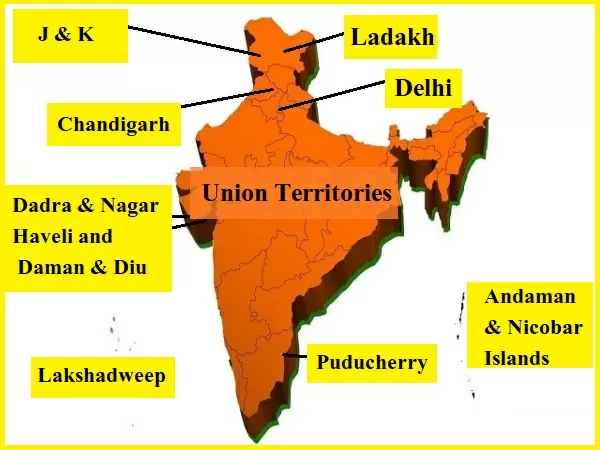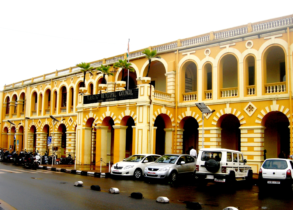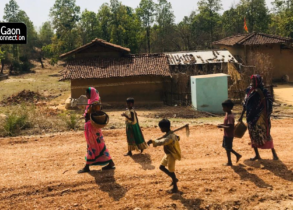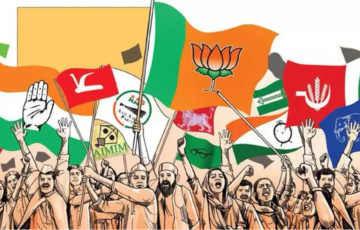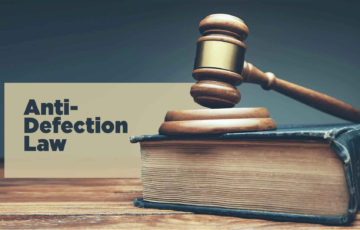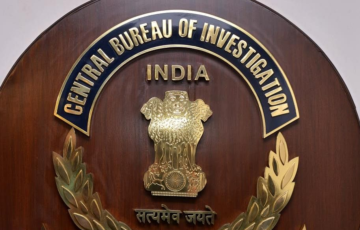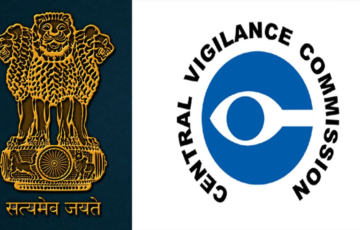UNION TERRITORIES
Introduction
The concept of territories administered by the Centre in India has a historical background predating independence. Scheduled districts were introduced in 1874, later becoming Chief Commissioners’ Provinces, directly administered by a Chief Commissioner under the Governor General/Viceroy. The States Reorganisation Act of 1956 reshaped India’s administrative divisions, creating Union Territories (UTs), with the Constitution (Seventh Amendment) Act of 1956 formalizing the concept of UTs. UTs are regions directly governed by the central government, often with less autonomy than full states, and they are typically used for areas with limited population or administrative capacity. UTs can evolve in status over time through legislative and administrative changes.
Union Territories in India
| Union Territory | Capital |
| Andaman and Nicobar | Port Blair |
| Chandigarh | Chandigarh |
| Dadra and Nagar Haveli | Silvassa |
| Daman and Diu | Daman |
| Delhi | New Delhi |
| Lakshadweep | Kavaratti |
| Puducherry | Puducherry |
| Jammu and Kashmir | Srinagar (Summer) and Jammu (Winter) |
| Ladakh | Leh (Ladakh) and Kargil (Ladakh) |
Reasons for the formation of Union Territories
- Union Territories (UTs) in India are created for various reasons, and their formation is usually based on specific requirements and circumstances. Some of the primary reasons for the creation of Union Territories in India include:
- Geopolitical Considerations: Certain regions may have strategic or geopolitical significance, and the central government may want to have direct control over them for reasons of national security or international relations.
- Small or Sparse Population: In cases where an area has a small or sparsely distributed population, it may not have the administrative capacity or resources to function as a full-fledged state. Creating a UT allows the central government to provide governance and services more effectively.
- Unique Cultural or Tribal Identities: Some areas with distinct cultural or tribal identities may be designated as UTs to preserve and protect their cultural heritage. UTs can provide a framework for recognizing and supporting these unique identities.
- Administrative Efficiency: Creating a UT can lead to more efficient governance and resource allocation, particularly in regions with specific developmental needs.
- Special Administrative Needs: Certain territories might require specialized administrative structures or legal provisions. Creating a UT allows for tailored governance and legislation to address these unique needs.
- Historical or Legal Factors: Historical considerations or legal agreements can sometimes lead to the establishment of UTs. For example, some UTs may have been created as part of a specific agreement or constitutional provision.
- Transition Phase: Some regions may start as UTs and later transition to full-fledged states as they develop economically and administratively. This gradual transition allows for more effective governance as regions grow.
- Proximity to the National Capital: UTs like Delhi and Puducherry were created to serve as the national capital territory and union territory, respectively, as they are home to the national capital and have unique governance arrangements to accommodate this status.
- Union Territories with Legislatures: In some cases, UTs are given their legislatures and greater autonomy to govern themselves while still being under the purview of the central government. This may be done to strike a balance between local self-governance and central oversight.
| Examples |
|
Administration of Union Territories
- The provisions for Union Territories in the Indian Constitution are laid out in Part VIII, encompassing Articles 239 to 241. Despite all Union Territories falling under the same category, their administrative systems vary. Various aspects regarding the governance of Union Territories in India are listed below:
- President’s Authority: Each Union Territory is governed by the President of India, who appoints an administrator to oversee its administration. Unlike a Governor in a state, the administrator acts as an agent of the President and not as the head of the state government.
- Types of Administrators: The administrator of a Union Territory can take different forms, such as a Lieutenant Governor (as seen in Delhi, Puducherry, Andaman and Nicobar Islands, Jammu and Kashmir, and Ladakh), Chief Commissioner, or Administrator (for Chandigarh, Dadra and Nagar Haveli, Daman and Diu, and Lakshadweep).
- Governor as Administrator: In some cases, the President can appoint the Governor of a neighboring state as the administrator of a Union Territory bordering it. In this role, the Governor operates independently of their state’s council of ministers. For example, the Governor of Punjab concurrently serves as the Administrator of Chandigarh.
- Legislative Assemblies: Legislative assemblies and councils of ministers led by chief ministers have been established in the Union Territories of Puducherry (since 1963), Delhi (since 1992), and Jammu & Kashmir (since 2019). These territories have local popular political institutions. However, the remaining five Union Territories do not have comparable popular political institutions.
- Parliament’s Supremacy: Despite the presence of legislative assemblies in some Union Territories, the ultimate control over these territories rests with the President and Parliament. Parliament retains the authority to enact legislation on any subject, including those on the State List, for all Union Territories.
- Puducherry and Delhi Legislative Powers: The legislative assembly of Puducherry has the power to make laws on subjects listed in both the State and Concurrent Lists. Similarly, the legislative assembly of Delhi can legislate on subjects within the State List (except for public order, police, and land) and the Concurrent List.
- Legislative Powers of Jammu and Kashmir: The legislative assembly of Jammu and Kashmir has the authority to make laws on subjects within the State List, with certain exceptions such as public order and police. It can also legislate on subjects listed in the Concurrent List.
- Regulations by the President: The President has the authority to issue regulations for specific Union Territories, including the Andaman and Nicobar Islands, Lakshadweep, Dadra and Nagar Haveli, Daman and Diu, and Ladakh. These regulations are meant to ensure peace, progress, and good governance in these territories.
- Legislative Power in Puducherry: In Puducherry, the President can legislate by rules when the legislative assembly is suspended or dissolved. These rules have the same legal force as laws passed by Parliament. The President’s regulations can also revoke or alter any laws passed by Parliament that apply to these Union Territories.
- High Courts for Union Territories: The Constitution allows for the establishment of High Courts for Union Territories by Parliament. Alternatively, a UT’s judicial matters can be placed under the jurisdiction of the High Court of a neighboring state. Delhi is the only Union Territory with its own High Court, established since 1966.
- Administration of Acquired Territories: The Indian Constitution does not have separate provisions for the administration of acquired territories. Instead, the constitutional provisions governing the administration of Union Territories also apply to acquired territories, ensuring a consistent legal framework for governance.
| SPECIAL PROVISIONS FOR DELHI |
|
Advisory Committees of Union Territories
- The Ministry of Home Affairs in India is responsible for governing Union Territories (UTs) in matters such as legislation, finance, budget, and the appointment of Lt. Governors and Administrators. In the five UTs without a legislative assembly, namely Andaman and Nicobar Islands, Chandigarh, Daman and Diu, Dadra and Nagar Haveli, Lakshadweep, and Ladakh, Advisory Committees exist.
- These committees, known as the Home Minister’s Advisory Committee (HMAC) and the Administrator’s Advisory Committee (AAC), are chaired by the Union Home Minister and UT Administrators, respectively. Members of these committees include Members of Parliament and elected representatives from local governments. The committees discuss and provide advice on general issues related to the social and economic development of the UTs, ensuring local concerns are considered in decision-making processes.
Difference between State and Union Territories
| Aspect | Indian States | Union Territories (UTs) |
| Governance Structure | Have their own legislative assemblies with Chief Ministers and Councils of Ministers. | May or may not have a legislative assembly; governed by an Administrator or Lieutenant Governor. |
| Representation in the Rajya Sabha | Have representation in the Rajya Sabha (Council of States). | Do not have representation in the Rajya Sabha. |
| Representation in the Lok Sabha | Have representation in the Lok Sabha (House of the People) based on population. | Have representation in the Lok Sabha based on the discretion of the President. |
| Local Laws | Can make laws on a wide range of subjects, including those in the State List and Concurrent List, under their respective state assemblies. | May have the power to make laws, but it is generally limited to subjects in the Concurrent List and specific areas provided by the President or Parliament. |
| Administrative Autonomy | Have a relatively high degree of administrative autonomy and power over various aspects of governance. | Generally have less administrative autonomy, with certain powers vested in the central government and the President. |
| Constitutional Role | Are explicitly mentioned in the Constitution of India. | Are created by the central government under Article 1 and Article 240 of the Constitution. |
| Local Governance | Have a well-established system of local governance, including Panchayati Raj institutions and Municipal Corporations. | May have local governance structures, but their scope and functions can vary. |
| Representation in State-Level Bodies | Participate in state-level bodies and organizations, like the Inter-State Council. | May not have representation in state-level bodies. |
| Financial Autonomy | Generally, have more control over their finances, including tax revenue collection and expenditure allocation. | May have limited control over their finances, with a significant portion of funding coming from the central government. |
| Police and Law & Order | Have their own state police forces and are responsible for maintaining law and order within the state. | May not have their own police force, and law and order are typically handled by central law enforcement agencies like the Indian Police Service (IPS). |
| Relationship with the Central Government | Interact with the central government as equals, negotiating on various issues and policies. | Have a more hierarchical relationship with the central government, with the latter having greater control over certain aspects of governance. |
Administrative System of Union Territories at a Glance
| Union Territory | Executive | Legislature | Judiciary |
| Andaman and Nicobar | Lt. Governor | No Legislature | Under Calcutta High Court |
| Chandigarh | Administrator | No Legislature | Under Punjab and Haryana High Court |
| Dadra and Nagar Haveli | Administrator | No Legislature | Under Bombay High Court |
| Daman and Diu | Administrator | No Legislature | Under Bombay High Court |
| Delhi | (a) Lt. Governor (b) Chief Minister (c) Council of Ministers | Legislative Assembly | Separate High Court |
| Lakshadweep | Administrator | No Legislature | Under Kerala High Court |
| Puducherry | (a) Lt. Governor (b) Chief Minister (c) Council of Ministers | Legislative Assembly | Under Madras High Court |
| Jammu and Kashmir | (a) Lt. Governor (b) Chief Minister (c) Council of Ministers | Legislative Assembly | Under Jammu and Kashmir High Court |
| Ladakh | Lt. Governor | No Legislature | Under Jammu and Kashmir High Court |

